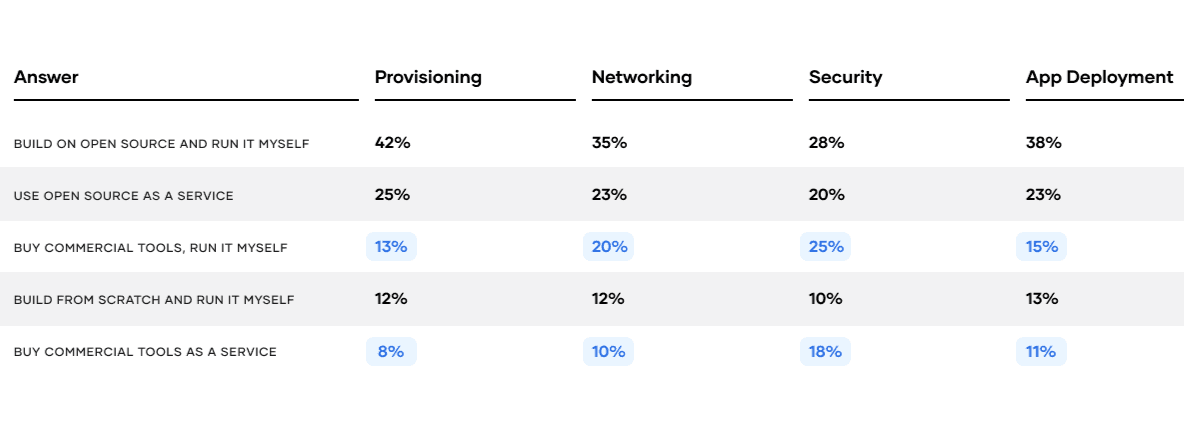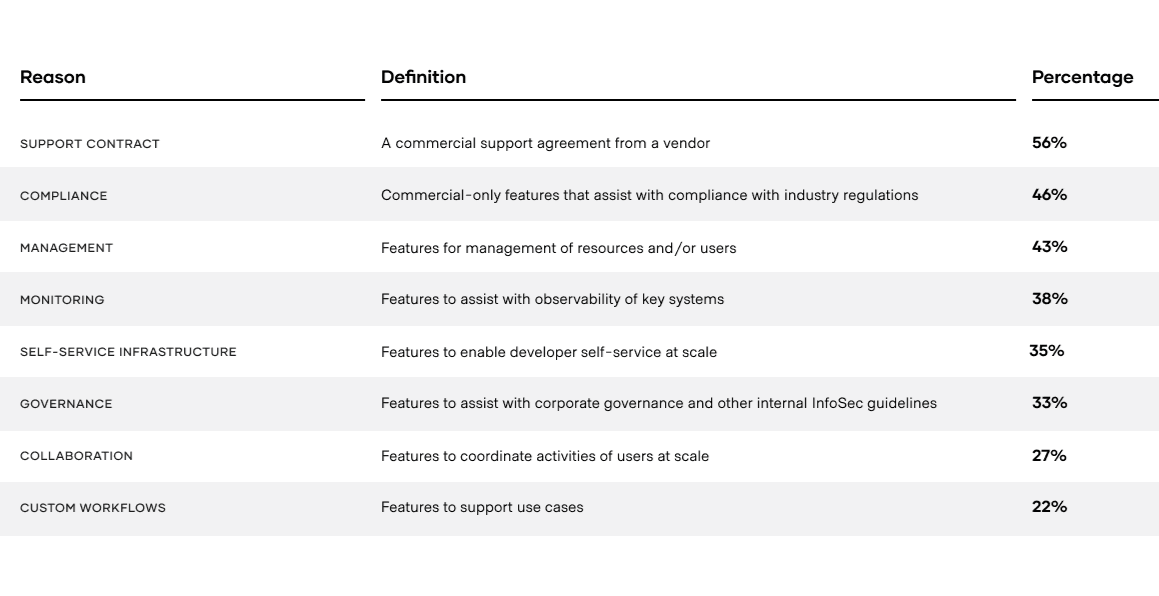At this point, the overwhelming popularity of open source software is well documented. What’s less understood is how IT teams actually deploy and run open source software, and why many organizations choose to adopt commercial distributions of open source projects. The inaugural HashiCorp State of Cloud Strategy Survey offers some useful insights into those crucial questions.
It turns out that the majority of the survey’s 3,200+ respondents -- technology practitioners and decision makers from the HashiCorp opt-in contact database — choose to build on open source projects and run the software themselves. Those that choose to buy their infrastructure tools typically do so in search of support, compliance, and management features as well as to make the software easier to use and speed their return on investment. And in the short term, it seems that the COVID-19 pandemic led many teams to rely even more heavily on open source.
»Most Practitioners Still Want to Do It Themselves When It Comes to Infrastructure Tools
For insight into how developers, IT operators, and practitioners prefer to work, we asked a foundational question:
“For infrastructure automation tools, what kind of offering does your organization currently use or plan to use?”
We gave respondents five choices across four categories: provisioning, networking, security, and application deployment. The choices were:
- Build from scratch and run it myself (full-stack DIY tooling)
- Build on open source and run it myself (For example, running open source HashiCorp Terraform, with custom scaffolding, on their choice of infrastructure)
- Use open source as a service (for example, the free tier of Terraform Cloud)
- Buy commercial tools, run it myself (for example, run HashiCorp Terraform Enterprise on your choice of infrastructure)
- Buy commercial tools as a service (for example, a paid version of Terraform Cloud)
Here’s a look at the response data:

Three things stand out here. First, respondents were much more likely to use cloud-enabled commercial tools for security than for other infrastructure components. Perhaps they appreciate the peace of mind that comes from a paid relationship in this critical area.
When it comes to provisioning — a mature category — respondents were much more comfortable building on open source software and running it themselves. It’s reasonable to infer that practitioners are more familiar with this technology, and organizations may face fewer management and compliance challenges here.
Lastly, very few people opt to build everything from scratch. Nearly four times as many respondents use open source projects for their infrastructure scaffolding.
The overall data supports the conventional wisdom that most organizations tend to use more open source software than commercial software. It’s easy to see why: the open-source community is a remarkable source of innovation, and the distribution model can be frictionless. There’s no procurement process; code is freely available. As such, popular open source sites like GitHub are the default starting place for many developers.
But even its strongest proponents will tell you open source isn’t a panacea. IT leaders must take responsibility, and publish guidelines on how open source software should be used in their organization. These best practices should encourage a healthy amount of experimentation with community-led projects while keeping guardrails to minimize risk. Savvy organizations will also encourage practitioners to seek commercial relationships with vendors as key technologies become crucial parts of a production deployment.
That’s one reason why most organizations start with open source software and continue using it indefinitely, while some organizations start with open source software and then opt to buy commercial versions at a later date when their needs grow. Not every open source project will warrant a commercial relationship; only the most important ones will.
»Companies Buy Infrastructure Tools for Support, Compliance, and Management Features
If most organizations still rely on open source, what are the reasons that some companies choose to buy their infrastructure tools?
To find out, the survey asked “If you buy tools, what are the reasons? (Select all that apply)”
Here’s a look at the results based on the possible reasons we supplied:

Total question respondents: 2,830
Support was the original value-add for open source software, and it appears to still be the top reason why companies purchase infrastructure tools. After all, companies’ most mission-critical applications depend on these tools. Buying your tools can give you access to paid experts who can assist with proper setup and configuration of production deployments. And in the event of a service interruption or prolonged outage, you’re definitely going to want product experts on-call to help you get things fixed as fast as possible.
It’s also unsurprising to see “compliance” and “management” rounding out the top three. Open source offerings tend to entice practitioners with initial productivity benefits, but use at enterprise scale often requires a commercial version.
»Quicker ROI, Ease of Use Also Boost Commercial Tools
The ranking of the choices above offers significant insight into why many organizations bought commercial infrastructure tools. But we also gave respondents the chance to explain their decision in their own words. Here our top 10 free-form responses, edited for clarity.
- “[Commercial tools, especially cloud services offer] better ROI than running ourselves”
- “By far the primary reason to buy tools is having fully functional (read: ‘tested’) tools when needed, [helping to alleviate] nightmare deployment or upgrade scenarios.”
- “[It’s] cheaper to buy vs build”
- “Don't reinvent the wheel”
- “[Commercial tools offer] Ease of use, quicker ROI”
- “Easier to buy than build”
- “[We] focus on what software is a differentiating capability, and buy the rest”
- “[Running tools is] not [a] core business.”
- “[With cloud services, you’re not] responsible for uptime”
- “Speed and opportunity cost (i.e., if [running tools is] not our value add, [we cannot focus on business] opportunity in other areas)”
These comments suggest that the value of infrastructure tools is evolving. Practitioners — and their employers — increasingly upgrade to commercial tools to help them go faster. Purchasing commercial tools outsources some of the operational toil that comes with building, running, and managing infrastructure at scale. Testing, validation, and CVE remediation are part of the tasks performed by the vendor on the user’s behalf.
To derive even more benefit from paying for your software, the next step is managed services in the cloud, powered by open-source technology. To be sure, support, compliance and management features are often “baked” into cloud services. But the practitioner interest in agility, distinctive competence, and ROI we saw in our survey is a new twist.
The appreciation for cloud services at the practitioner level squares also with the overall multi-cloud findings in the survey. Individual teams are at their most productive when they can use a clearly defined set of cloud services that meets their requirements. In fact, it's often an anti-pattern for a small team to rely on two different public clouds.
But when you zoom out to the macro perspective, organizations have hundreds of teams working with infrastructure. In aggregate, these teams will likely be using multiple different clouds to meet their particular needs and suit their preferences.
»COVID Boosted the Use of Open Source Software
Finally, of the 2,900+ respondents to this question in our global survey, 39% said the COVID-19 pandemic led them to increase their use of open source software to more rapidly respond to new business needs.
Is this finding surprising? It shouldn’t be.
Developers have long turned to open source repos to grab bits of code to help them finish up a feature or fix a persistent bug. COVID put even more pressure on development teams to deliver quickly. Consequently, some aggressive open source adopters appear to have become even greater open source users.
»Learn More
For more insights into how companies are investing in cloud and multi-cloud environments, check out the full HashiCorp State of Cloud Strategy Survey.
Related posts






